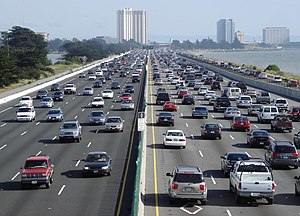
- Image via Wikipedia
Did you drive to work today? If so, you’re probably an amateur driver, with only slight accreditation to operate a complex, heavy, and powerful machine.
You drive as an amateur in the midst of professional drivers — truckers, taxi drivers, chauffeurs, bus drivers, and police. Yet you probably feel as capable as these other drivers, and might even justifiably dispute the skills of some of the professional drivers you encounter.
Clay Shirky thinks this is analogous to the model for journalism in the future.
In a recent post on Cato Unbound, Shirky reminds us that journalism is a two-way street, so to speak — it isn’t only about assembling the facts and narrative of the news, it’s also about “assembling a public to read and react to those stories.”
The upheaval in journalism Shirky describes comes on many fronts — the subsidy model publishers have relied upon is upset since the bottleneck of print is disrupted; the public captured by the bottlenecks of print manufacturing and distribution has been released; and the role of the professional is shifting, from doing it all to doing some specialized function in the midst of a host of amateurs, some of whom are highly skilled.
Which brings us back to driving:
Like driving, journalism is not a profession — no degree or certification is required to practice it, and training often comes after hiring — and it is increasingly being transformed into an activity, open to all, sometimes done well, sometimes badly, but at a volume that simply cannot be supported by a small group of full-time workers. The journalistic models that will excel in the next few years will rely on new forms of creation, some of which will be done by professionals, some by amateurs, some by crowds, and some by machines.
As the audience gains access to communication tools and confidence in using them, self-assembling publics, a blend of professional and amateur content, and a labyrinthine set of routes through that information will emerge.
The lesson for publishers and information specialists? New rules of the road are being written every day.
Discussion
7 Thoughts on "Journalism and Driving — Technology Enables Amateurs"
I strongly disagree that journalism is not a profession. Yes, anyone can practice reporting, but journalism is a learned skill, and quality journalism takes training. Sending a tweet that you saw a plane crash is not journalism. Quoting Warren Ellis talking about David Simon (co-creator of The Wire):
“His argument is that journalism is an honest-to-god job, with skills, that you have to learn in order to do it right. Citizen journalism just doesn’t cut it….Citizen journalism ate it in the US. Dan Gillmor, who had been talking of nothing else for years, launched Bayosphere–because what the world needed, see, was another website about people talking about the San Francisco Bay Area–which fell apart five minutes later. Citizen journalism looks like sites like westportnow.com, whose above-the-fold right now blazes with the hottest news story in town–local church members knitted some woolen caps for charity… The metroblogging sites…are great fun, but at best they’re arts journalism and in general they’re a listings magazine and linkbloggers. They’re very rarely working their own sources, doing original reporting or in broad terms, doing the work of journalists. The five rules of journalism–who, what, where, when and why–aren’t there because people like pissing you off with rules. They’re there because that’s how you learn things and that’s how you explain things, and that, eventually, is how you see that events and people are connected…and that’s how we build up a picture of the world and begin to understand where we are today and what it really looks like.
Shirky does get two things very right in the article though–news organizations are going to have to cut way back as far as staffing, and become much leaner. John Gruber has a great piece on this here.
Shirky’s other good point is that this upheaval is likely not a good thing, and that society is likely losing something in the process.
I think Shirky says that some things will be lost, some gained, and that we won’t know what these are for years. Frankly, I think bringing more people into the tent of reporting, observation, and accountability is a good thing.
I think Shirky’s point about journalism as a profession is that it is becoming more of an activity because the tools are available to all — and that a bottleneck of resources is what made it appear as a profession, because you needed a degree to get anywhere in the organizations the bottleneck created.
We still have professional drivers, and rely on them, but they aren’t the majority of drivers. We will still have journalists who see journalism as a trade and a profession, but they won’t provide the bulk of news reporting or analysis. In fact, that inflection point may have already come and gone.
Amateurs will dominate, just as with driving.
And frankly, I’d rather have my amateur friend drive me around than some of the accredited taxi drivers I’ve encountered. Yikes!
I think there’s a place for both, really, and we’d be poorer if we lost either part of the equation. It’s great that people directly involved in a situation can give us instant, on-the-ground reports of what’s happening. But it’s also great when we can get deep, investigative pieces that explain how and why something happened. For example, an amateur could have alerted us that there was a break-in at the Watergate office complex. The story told by Woodward and Bernstien was something else altogether.
And, no, I don’t think a random citizen journalist would have the time or resources to do the sort of journalism that Woodward and Bernstein did in that case. That’s why I think it’s necessary to clearly define “journalism”, it’s more than just taking a picture or stating that something happened. There are very few tweets that can tell you who, what, where, when and why in 140 characters.
I agree with David. Given scholarly publishers’ traditional role in generation and certification of content, perhaps the question we should ask is where – to extend Kent’s analogy – we should build toll roads that have less traffic, get you where you actually want to go, and are not cluttered by unlicensed drivers.
To David’s comment about how Twitter can’t support journalism:
“Jupiter Smashed by Comet, NASA Confirms, Leaving Scar http://bit.ly/mTShd 4 minutes ago”
Who, what, where, when, and the why is obvious (big planet = more gravity). Plus a link to a full story.
Other links worth exploring:
http://www.readwriteweb.com/archives/twitter_for_journalists.php
http://scobleizer.com/2007/04/12/mexico-city-earthquake-reported-on-twitter-first/
http://www.zoliblog.com/2008/03/23/earthquake-in-japan-twitter-reports-first-again/
One thing inherent to Twitter is the stacking of materials. This is one way to see a story “trending” as they say. And that’s news.
The key there is the link to the full story, written by a professional journalist. The tweet is, as I’ve defined it, “reporting”. The longer piece is much more informative and what I’d call “journalism”. This is a great example of the two serving each other, one calling something to our attention and the other fully explaining it.
I don’t see any mention of “who” in the tweet (the article discusses the amateur astronomer who first saw it), I don’t see much “where” (unless you define an entire planet as “where”–the article specifies where on the planet this occurred), I don’t see any mention of “when” (some time between Friday and Sunday apparently) and “why” is far from obvious (what is the history of such things happening, what does it mean, how would this compare with a similar strike on earth and what is NASA planning to do to learn more?).
The earthquake links are similarly uninformative, other than saying, hey, there’s an earthquake happening. Useful information, but hardly the whole story.
Different tools have different strengths.
John Stewart – Most trusted newsreader…
http://www.timepolls.com/hppolls/archive/poll_results_417.html
I think that tells us something about where journalism is in 2009? And by the way, just ‘cos I’m over here in the UK, doesn’t mean I think our lot are any better. We have the Daily mail, and the Mirror, and the Sun, and the News of the World and….
Jon Stewart, assembling a public, an International Public and having real clout. The only time I saw Tony Blair look scared, was when his was on the Daily Show.
![Reblog this post [with Zemanta]](http://img.zemanta.com/reblog_e.png?x-id=63036a25-60b8-4206-8c0c-275efb7f11d6)


